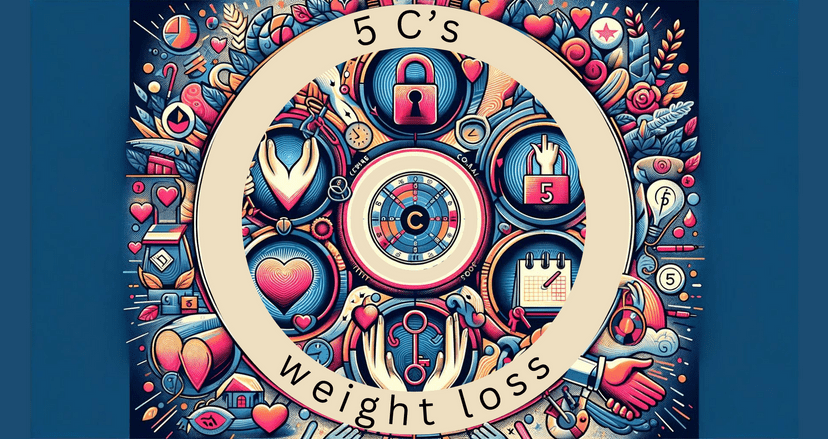What is Red Flag Weight Loss?

Identifying Red Flag Weight Loss
Have you had a significant drop in your weight that you can't quite explain? If so, it's clear that you're grappling with what health professionals term as red flag weight loss. This concept pertains to sudden, inexplicable weight loss that isn't connected to changes in dietary habits or increases in physical activity. Acknowledging potential unhealthy weight loss signs is integral to ensuring optimum health and systemic function.
Definition and Examples of Red Flag Weight Loss
In essence, red flag weight loss is inadvertent and rapid loss of body mass that lacks a lucid justification. For instance, if you find yourself shedding a sizable amount of weight amidst consistent dietary habits and regular exercise patterns, such decrement could be a signal ringing caution. Furthermore, if fatigue, a loss of appetite, or feeling ill accompanies your weight loss, these could be intensifying indications of an internal health dilemma.
It is critical to note that red flag weight loss isn't associated with deliberate efforts to slim down via changes in diet, physical activity, or lifestyle adjustments. Instead, it proclaims possible underlying health concerns that your body might be grappling with unbeknownst to you.
Common Thresholds for Concern
While there are no hard and fast rules that dictate the exact amount of weight loss that should trigger concern, generally, losing 5% or more of your body weight within a 6-12 month period without striving for it signals a red flag. Another commonly used threshold by clinicians is the unsuspected loss of over 10 pounds. These boundaries aren't foolproof but act as useful indicators to identify potential red flag weight loss scenarios.
Distinguishing Between Healthy and Unhealthy Weight Loss
It is vital to discern between healthy and unhealthy weight loss situations. Healthy weight loss is gradual, purposeful, and usually a result of increased exercise, healthier eating habits, or other conscious lifestyle changes. Contrastingly, red flag weight loss is always unintentional, rapid, and tends to manifest alongside other symptoms such as fatigue, loss of appetite, and generally feeling unwell.
Notably, while losing weight may sometimes be beneficial, especially if you're overweight or obese, losing too much weight without trying can be a sign of distress. It can expose your body to various health risks such as nutritional deficiencies, weakened immune system, and even severe conditions like cancer, diabetes, or thyroid issues.
In summary, always stay vigilant and cautious about your body changes. Recognize the signs of red flag weight loss early and consult a health professional for advice and further examination to ensure overall health and wellbeing.
Potential Health Implications
One of the first signs of a potentially serious health problem may be red flag weight loss. While many people strive for weight loss to improve their health or physical aesthetics, it's crucial to understand the importance of healthy, steady, and maintained weight loss over time. Sudden, unexplained weight loss can be a symptom of significant health issues such as metabolic disorders, chronic diseases, or mental health conditions.
Link Between Red Flag Weight Loss and Chronic Conditions
The body is a complex machine that needs to function optimally for vitality and longevity. When you lose weight unexpectedly or at a rapid pace, it could signal that your body is fighting a chronic condition. Diseases like diabetes, cancer, and heart disease are often accompanied by weight loss that occurs without a deliberate attempt to shed pounds with diet or exercise. For example, cancer tumors often burn large amounts of calories, and this high caloric expenditure can lead to noticeable weight loss. Furthermore, conditions like hyperthyroidism or adrenal gland disorders can speed up metabolism leading to sudden weight loss.
It's critical to listen to your body's signals and consult a healthcare professional if you experience unusual or rapid weight loss. Early diagnosis and treatment of many chronic ailments can significantly improve patient outcomes.
Metabolic Disorders and Weight Loss
Metabolic disorders can also lead to weight loss. These conditions interfere with the body's ability to metabolize, or break down, nutrients in the food you eat. Examples are hypothyroidism, hyperthyroidism, and diabetes. In metabolic disorders, the rate at which your body burns calories can be affected, often leading to unduly rapid weight loss.
For instance, someone with hyperthyroidism has an overactive thyroid gland that produces too much thyroid hormone, leading to accelerated metabolism and unplanned weight loss. On the other hand, untreated diabetes can also lead to weight loss as the body starts burning fat and muscle for energy because it can't utilize the sugar available in the blood.
The Psychological Impact and Eating Disorders
Lastly, it's important not to overlook the psychological implications of red flag weight loss. Conditions like depression, anxiety, and stress can lead to a loss of appetite and, subsequently, weight loss. Eating disorders, such as anorexia nervosa, bulimia, and binge eating disorder, are severe conditions characterized by extreme emotions, attitudes, and behaviors surrounding weight and food. These disorders can have serious health implications and are often coupled with sudden, unintended weight loss.
Remember, your mental health is just as important as your physical health. If you're experiencing any sudden change in appetite, weight, or your relationship with food and body image, it may be beneficial to seek help from a mental health professional.
Understanding red flag weight loss and the potential health implications is vital. It's essential to approach weight loss with knowledge and care, recognizing when it may indicate a more serious underlying condition requiring medical attention.
Responding to Red Flag Weight Loss
Detecting a red flag weight loss is a serious matter that requires immediate attention and well-informed action since it usually indicates that weight loss is a symptom of an underlying health condition. Red flag weight loss is not a direct consequence of disciplined workout routines or a healthy diet – it's unsettled, unexpected, and unintended.
Now, red flag weight loss doesn't mean feeling a few pounds lighter after a bout of the flu; it refers to a significant drop in weight that was neither planned nor desired, specifically losing 5-10% of your body weight in a period of six months to a year without any significant changes to your diet and physical activity. Loss of muscle mass, failure to regain lost weight, and continued weight drop despite increased food intake are just a few signs to watch for.
In the case of severe unintended weight loss, it is important to not only address the symptom but also to dig deeper and understand why it is occurring.
When and How to Seek Medical Advice
If you've experienced such significant, unexplained weight loss, it's time to seek medical advice. A meeting with your healthcare provider should be scheduled immediately. The goal of this visit is to discuss your weight loss symptoms and to begin determining any root causes for it. Here is how you should prepare for such an important consultation:
Preparing for Your Doctor's Visit
When preparing for your doctor's visit, consider the following steps:
-
Document the amount of weight lost: Keep track of your weight at consistent intervals and note any significant changes. Provide accurate, detailed information to your healthcare provider for effective diagnostic decision-making.
-
Prepare a list of symptoms: Keep a log of any unusual symptoms you may have noticed in connection with your weight loss. Symptoms may vary from loss of appetite and change in taste or smell to abdominal pain, fatigue, or even mood changes.
-
Analyze dietary patterns and changes in physical activities: Identify significant changes in your eating habits or activity levels which may have precipitated the unintentional weight loss. While doing so, consider factors like changes in your job, life stresses, recent travels, or any traumatic events.
-
Gather your medical history and family medical history: Make a comprehensive list of all illnesses or medical conditions you have or have had in the past. Additionally, include information about any diseases or conditions that run in your family.
Using the compiled information, your healthcare provider will be better equipped to reach diagnosis, and then, tailor an effective treatment strategy accordingly.
Treatment and Monitoring Plans
Once evaluated by your healthcare provider, be sure to actively engage in the treatment plan developed for you. You might be referred to a specialist, depending on the suspected underlying condition. Treatment may vary from medications, dietary changes, physical activity, or even psychological counselling.
Adherence to the established treatment plan should be a priority, as a proper follow-up is key to managing any health condition effectively. Regular check-ins with your healthcare provider will assist in monitoring the progress of your recovery, adjusting treatment strategies as necessary, and ensuring that your health is progressing in the right direction.
In all cases, swift action and ongoing monitoring are essential when dealing with red flag weight loss. It's important to remember that such a prompt response and commitment to treatment significantly increase the chances of successful recovery and maintaining optimal health in the long run. Remember, your health is an investment, not an expense.
In Summary
In essence, this article has delved into the concept of red flag weight loss. This type of weight loss refers to unexplained, sudden decrease in body weight that is not linked to changes in diet or exercise. This potentially alarming sign could indicate underlying health dilemmas such as chronic diseases, metabolic disorders, or mental health conditions.
Recognizing the difference between healthy and unhealthy weight loss is critical. While healthy weight loss is gradual and results from deliberate lifestyle changes, red flag weight loss is unintended and often coexists with other alarming symptoms. Undoubtedly, early recognition and proactive action towards this sign could be a literal lifesaver.
The plan of action in dealing with potential red flag weight loss includes:
- Acknowledge the seriousness of sudden, unexplained weight loss. This weight drop is not a positive sign from successful dieting or intense workouts, but rather could signal hidden health issues.
- Stay vigilant about body changes and monitor your weight regularly. If you notice a drastic decrease in body weight (losing 5-10% of your body weight within 6-12 months without trying), contact a health professional.
- Prepare thoroughly for your doctor's visit, documenting all necessary information.
The action steps include:
-
Monitor your weight regularly: Regular weight checks are crucial for detecting sudden, unexplained weight loss.
-
Observe other potential symptoms: Aside from sudden weight loss, track other symptoms such as loss of appetite, fatigue, sense of illness, among others.
-
Prepare for the healthcare provider visit: Document your symptoms, changes in your lifestyle, and your health history. Provide this information in your meeting with your doctor to assist in reaching an accurate diagnosis.
-
Follow through your treatment plan: Adhering to the treatment plan developed by your healthcare professional is key to managing any underlying disease timely and effectively.
Always remember that your health is an investment, not an expense. Staying alert of any significant, unusual changes in your body could help you prevent serious health issues or even save your life. It's crucial to promote a proactive approach to overall well-being for a long, healthy life.













